- Matt R.
- Shower Trays
- 55 views
Are you looking to revamp your shower space but aren’t sure where to begin? Look no further than this detailed shower tray buying guide, which covers everything you need to know about selecting the best shower tray. In the following sections, you’ll learn why shower trays are essential for any functional bathroom, how they’re made, and how you can pick the ideal option for shower enclosure style. By reading this guide, you’ll gain the knowledge needed to make an informed decision when choosing a shower tray, avoid costly mistakes, and enjoy a shower setup that best suits your preferences for years to come.
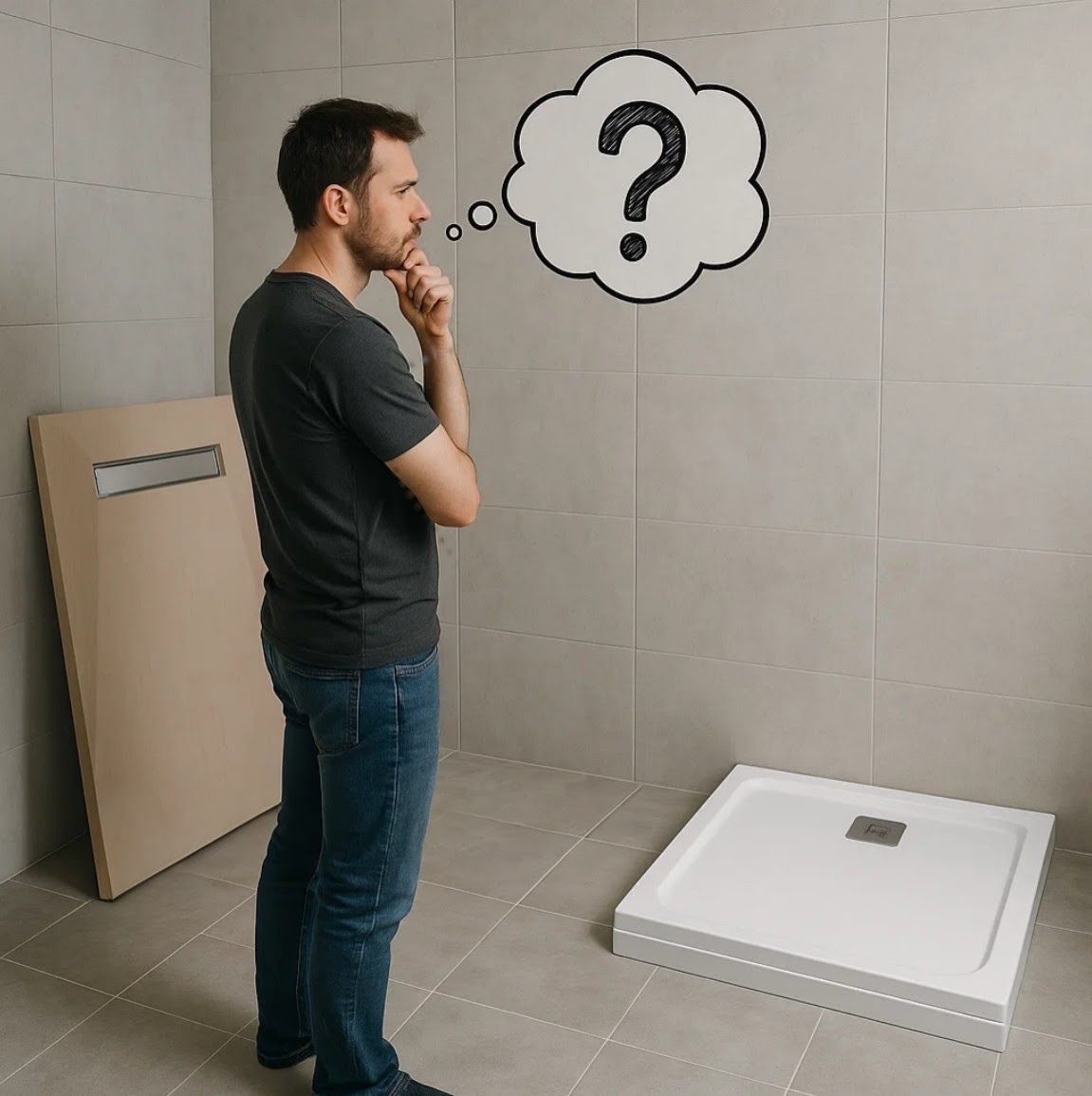
Table of Contents
- Why the Right Shower Tray Matters
- Shower Tray Types and Materials
- Shower Tray Shapes
- Shower Tray Sizes
- Shower Tray Drains
- Shower Tray Colours
- Shower Tray Enclosures and Screens
- Shower Tray Installation Tips
- Shower Tray Maintenance
- Key Takeaways
Why the Right Shower Tray Matters
Selecting the correct shower tray is critical in achieving a comfortable, hygienic, and durable shower space. The shower tray forms the floor of the shower, collecting water and directing it toward the shower waste. Modern bathrooms increasingly incorporate a wet room concept (read the definition of wet room). Whether you prefer a flush-fitting acrylic shower tray, raised square shower tray, or walk-in wet room shower tray the choices you make at this stage will influence aesthetics, practicality, and maintenance ease.
Choosing the right shower tray depends on several factors:
- Bathroom size, layout, and décor – Make sure the tray you select complements the available space, ensuring seamless installation and a visually pleasing result.
- Personal preference regarding height (for instance, a low-profile shower tray design) – This choice influences not only the overall look of the shower area, but also accessibility, which can be important if you want an easier step-in experience.
- Material durability – Acrylic shower trays are known for being lightweight and budget-friendly, while stone resin trays offer a more substantial, premium feel. Ceramic shower trays provide a classic, robust option but tend to be heavier and less flexible in terms of custom shaping. Wet room shower trays often include an XPS foam core with cementitious coatings and mesh reinforcement, forming a strong yet versatile base for seamless, level-access installations.
- Finishing and integration – Wet room shower trays can blend seamlessly with the rest of your bathroom floor surface (like tiling or microcement), creating a cohesive look that also simplifies cleaning and maintenance.
- Additional features like anti slip shower tray surfaces – Adding a lightly textured or specially coated surface can make showers safer for families with children or older adults, helping prevent unwanted slips.
A well-chosen shower tray not only complements your shower enclosure but also extends the overall lifespan of your shower area.
Wet Room vs. Traditional Bathroom
A wet room is essentially a fully waterproofed space where the shower area and the rest of the bathroom floor are on the same level, often without a dedicated shower tray or enclosure. By contrast, a traditional bathroom usually includes a defined shower or tub with raised edges or thresholds. This design difference creates a more open, accessible look in a wet room, although it typically requires more thorough waterproofing to protect floors and walls.
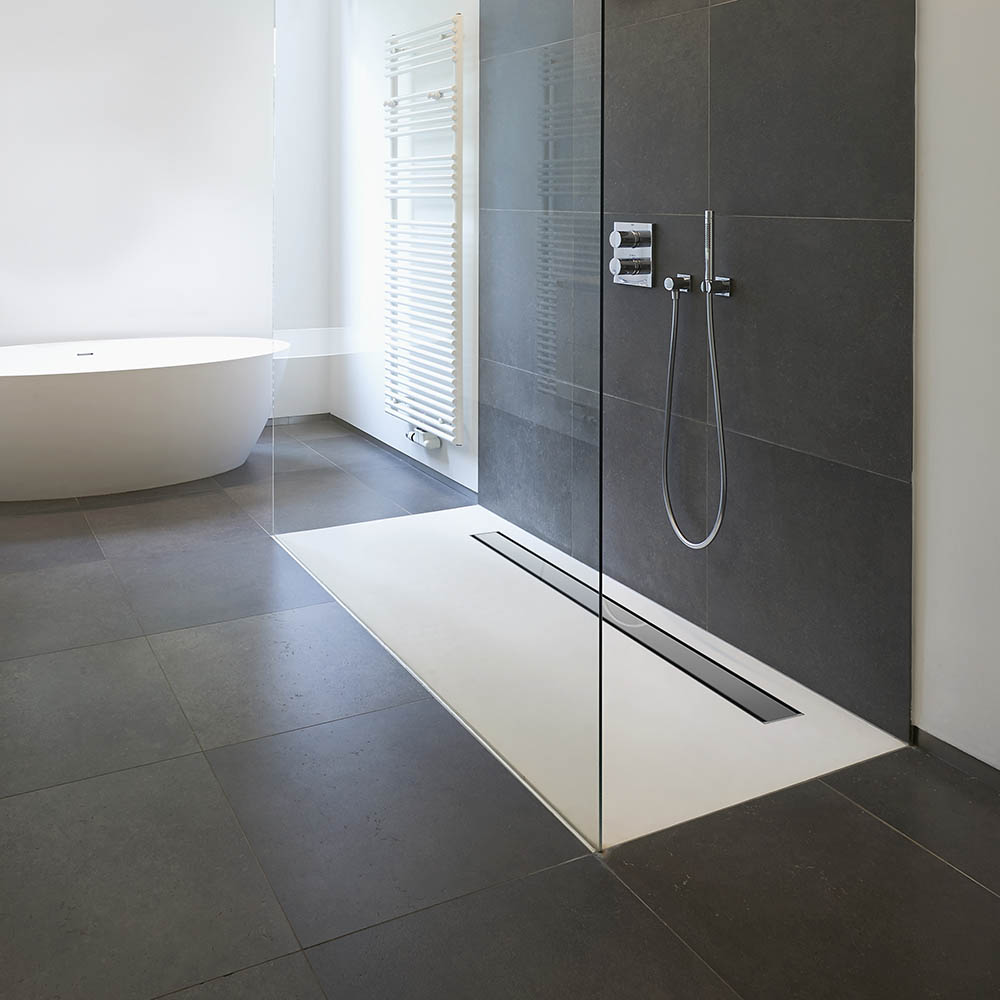
Types of Shower Trays
Among the most critical things to consider before buying is the right shower tray material. Shower trays come in several compositions, each with unique pros and cons:
| Type | Key Features | Pros | Cons |
|---|---|---|---|
| Acrylic Shower Trays | Lightweight Easy to install Budget-friendly May scratch if not handled carefully |
+Simple, quick installation +More affordable than other options |
–Prone to scratches –Less durable than heavier trays |
| Wet Room Shower Tray | Sits flush to floor level Can match surrounding floor material (tiles, microcement) Eliminates raised edges for an open, minimalist look |
+Seamless, modern design +Integrates easily with the rest of the bathroom +Barrier-free, accessible solution |
–More complex installation –Requires thorough waterproofing |
| Stone Resin Shower | Heavy but very sturdy Luxurious, solid feel Often more expensive May require professional fitting |
+Extremely durable and long-lasting +Premium appearance and feel |
–Difficult to maneuver due to weight –Higher price point –Often requires professional installation |
| Acrylic Capped Stone Resin | Combines stone resin strength with an acrylic finish Gel-coated for extra surface protection Reinforced with wood or polyurethane resin |
+Good balance of sturdiness and lightweight design +More resistant to damage than standard acrylic +Smooth, easy-to-clean finish |
–Typically more expensive than standard acrylic –Can still be relatively heavy |
| Gel coated stone resin | Stone resin foundation with an advanced gel-coat layer Highly resistant to scratches and staining |
+Enhanced durability and longevity +Premium look and feel +Easy to maintain once installed |
–Heavier than standard acrylic –Often more expensive –May require professional installation |
| SMC (Sheet Moulding Compound) Shower Trays | Composite of polyester resin + glass fibre reinforcement Mid-range weight and cost Good heat and chemical resistance |
+More rigid than basic acrylic +Lighter than stone resin +Uniform finish +Potentially simpler to install than heavier trays |
–Limited colour/finish selection –Not as widely available –Can be more expensive than standard acrylic |
Your choice should reflect your bathroom décor, budget, and how often the shower will be used. If you value a sleek, open-plan aesthetic and seamless integration with the rest of your bathroom floor, a wet room shower tray may be the most appealing option.
Shower Tray vs. Wet Room Shower Tray
A standard shower tray typically includes a defined, raised border to keep water within the shower area. It’s often made from standalone materials like acrylic or stone resin and can be installed on top of or slightly recessed into the bathroom floor. A wet room shower tray, on the other hand, sits flush with or very close to the floor level, blending smoothly with the surrounding tiles or finish. This design offers a more open, barrier-free feel, although it also requires thorough waterproofing to safeguard the broader bathroom area.
Shower Tray Shapes
Selecting the right shaped tray can be difficult, particularly if you have an unconventional bathroom layout. For an overview of the main shower tray shapes, let’s explore some of the most popular options below:
Square Trays
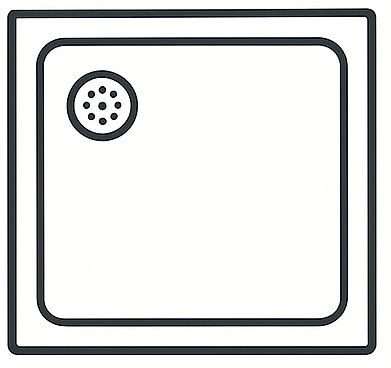
Great for small bathrooms, as they require minimal floor area. Square shower trays are often paired with sliding shower doors or hinged doors.
Rectangular Trays
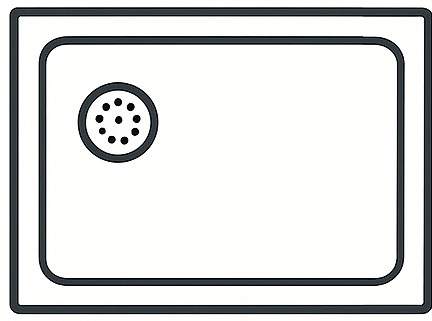
Best suited to larger bathrooms, providing a spacious shower area. Rectangular shower trays offer an elongated space that adds a sense of luxury to the bathroom.
Quadrant Shower Trays
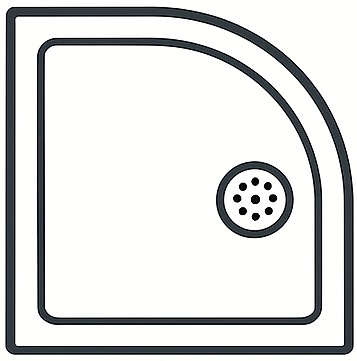
Known for their curved front, quadrant trays conserve corner space while maintaining enough standing room. If you need a bit more length, offset quadrant shower trays are a go-to choice.
D Shaped Shower Trays
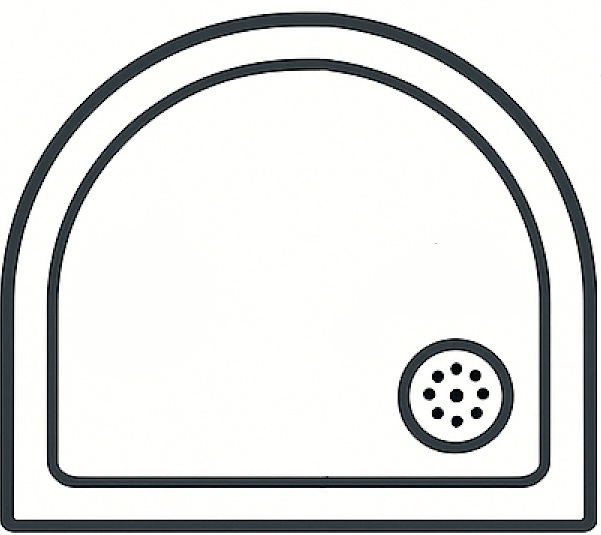
Resembling a semi-circle or “D” shape, these trays combine a curved front with straight sides along the wall. Perfect for mid-sized bathrooms or any layout requiring a blend of practicality and design flair.
Bespoke Shower Trays
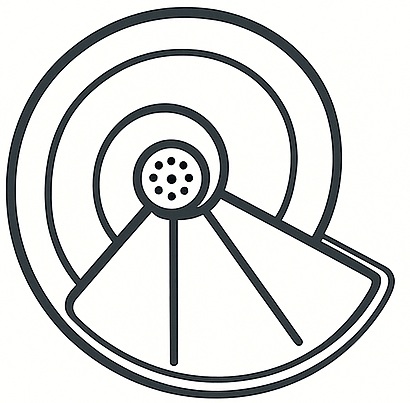
By opting for a wet room shower tray, you can enjoy nearly limitless customization — even unique shapes like a seashell design — to achieve a truly personalized bathroom aesthetic.

Shower Trays Sizes
When planning your ideal bathroom, shower tray size plays a crucial role in both the look and functionality of the space. Smaller rooms typically benefit from compact square shower trays (like 800 x 800 mm), while larger bathrooms accommodate more spacious rectangular options (such as 900 x 1600 mm or 900 x 1850 mm). Here you can read more about shower trays sizes.
If your layout is unconventional, you can opt for bespoke trays that tailor not only the length and width but also drain placement and thickness. Whatever size you select, ensure you properly prepare the subfloor and install the tray securely to maintain a leak-free, seamless connection with the surrounding bathroom floor.
See our most popular wet room shower trays sizes:
How to Measure a Shower Tray
Before purchasing, it’s vital to measure a shower tray accurately. Proper measurements help ensure everything lines up with your wall tiles, the shower enclosure glass, and any existing pipework.
- Identify the Shower Area – Mark the floor where the tray will sit. If you have a curved front or any angled walls, note these features carefully.
- Record Exact Dimensions – Use a measuring tape to find the length and width. If you’re buying a custom or offset shape, track the corner radius or offset edges.
- Consider Tray Height – Look under the floor to see if you have enough space for the waste pipe. If not, you may need a raised shower tray. If you want a near-seamless look, opt for a low-profile tray model, assuming your subfloor allows it. When buying a wet room shower tray, you have options ranging from 20 mm to 60 mm in thickness.
For an even more comprehensive approach to planning your bathroom layout, try the online Bathroom Layout Planner.
Before finalizing the size of your shower tray, double-check that any doors (including shower doors and bathroom entry doors) and adjacent fixtures won’t collide with the tray once installed. Precise measurements not only prevent awkward layouts but also ensure enough space for comfortable movement within your bathroom.
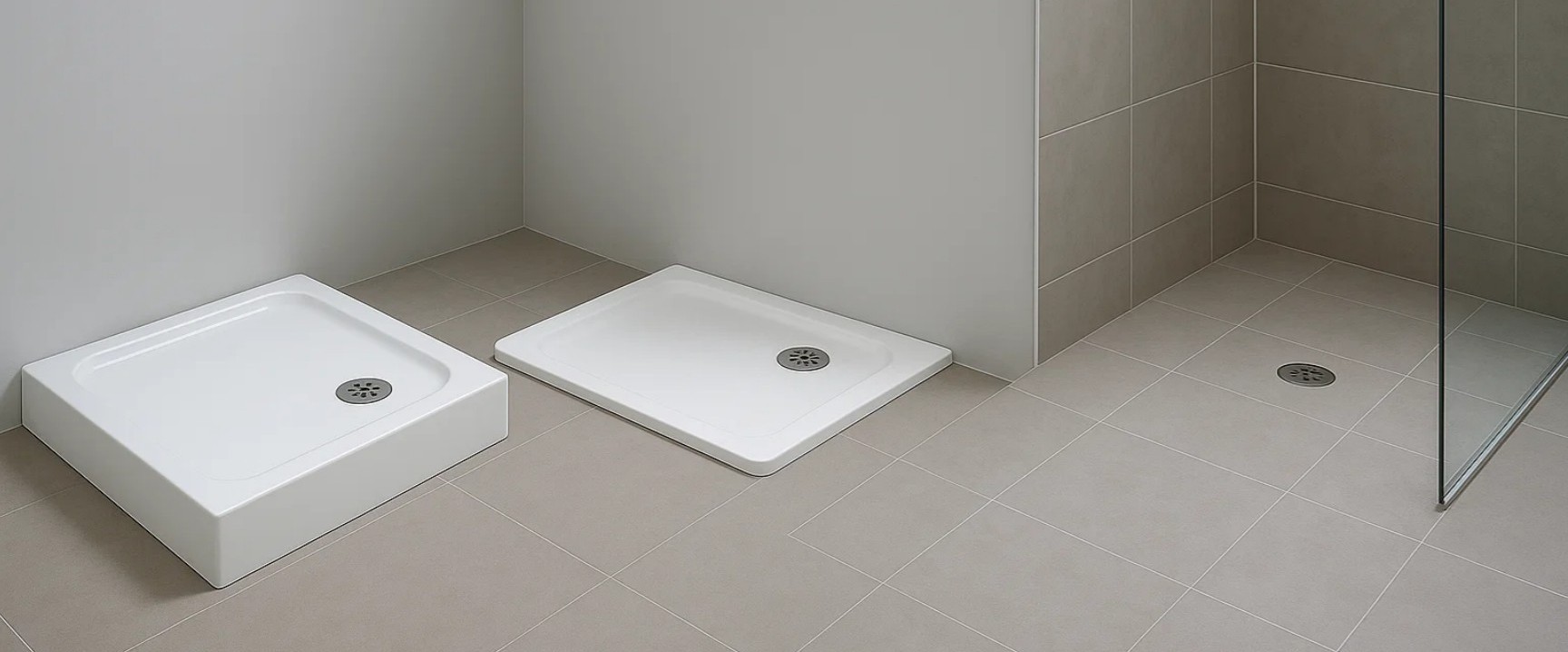
Shower Tray Height – Raised Tray vs. Low-Profile Options
A crucial decision is whether to install a raised tray or a low-profile shower tray. This largely depends on plumbing constraints and personal aesthetic preferences.
Raised Tray
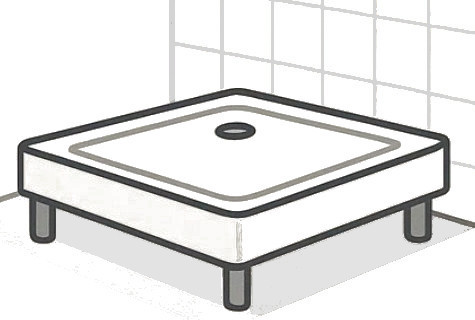
If you’re installing a shower where the drain cannot be recessed into the floor (common with certain waste pipe setups), you’ll need a raised shower tray. It typically sits on a small platform or riser legs, making it easier to reach the drainage connections below.
Low-Profile Tray
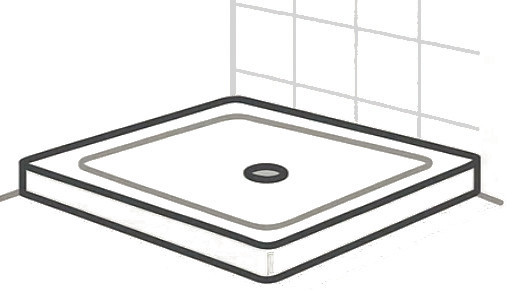
Perfect for creating a modern shower feel, this style can sit almost flush with the wet room floor. It allows easy access to the shower, which is particularly beneficial for individuals with mobility issues or those seeking a minimalist look.
Walk-In Shower Tray
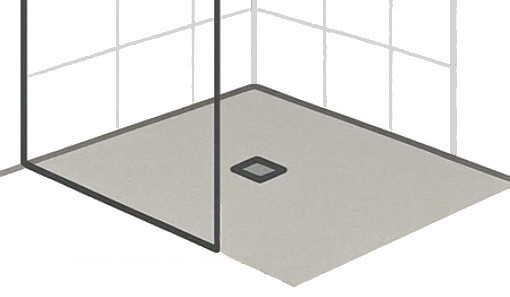
A walk-in wet room shower tray effectively merges with your bathroom floor, creating one continuous surface without any edges. This design further reduces barriers, making your shower more accessible while lending a spacious, open feel to the entire bathroom.
Choose the height that aligns with the functionality and style you envision for your bathroom space.
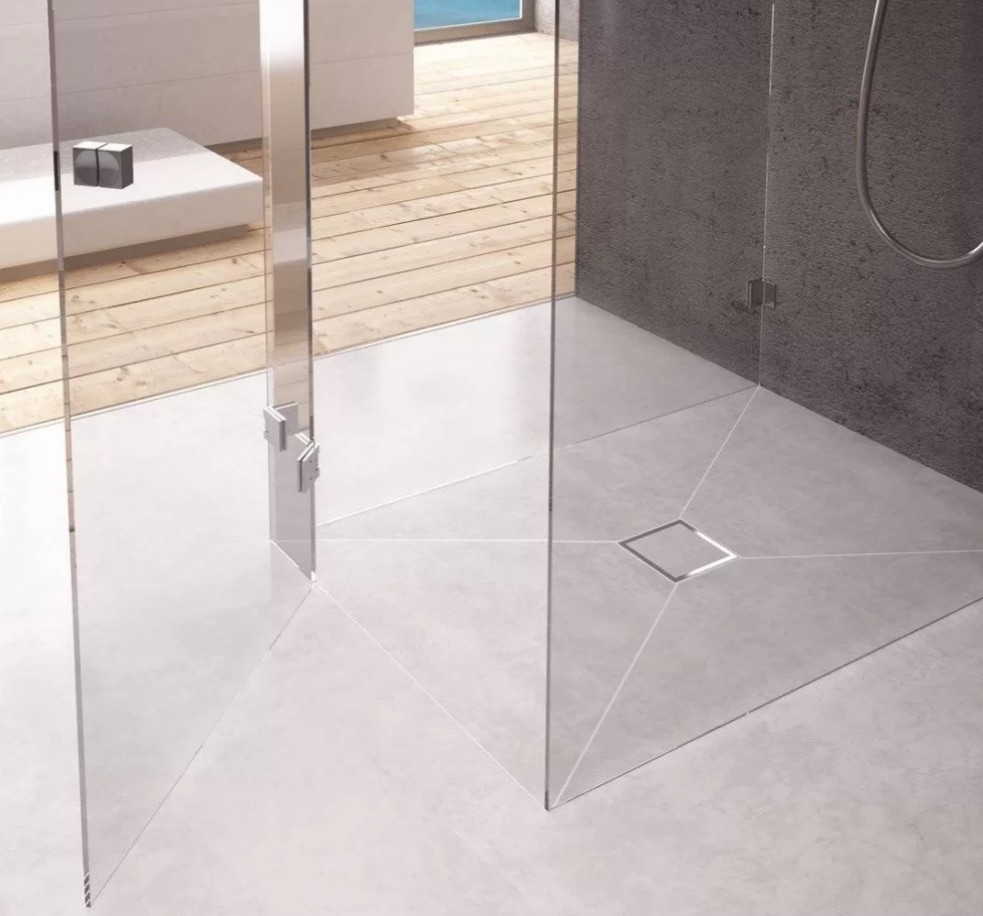
Choosing the Right Drain Type For Shower Tray
When planning your wet room or traditional shower, you’ll typically encounter two main drain options: linear and square. Linear drains offer a sleek, minimalist appearance and can be positioned almost anywhere – along the wall, at the center, or even offset. Square drains, meanwhile, are a classic choice that often suits smaller showers or bathrooms with more traditional layouts.
See our range of Wet Room Shower Trays with Square drain.
Both varieties come in a wide range of sizes and finishes, allowing you to match everything from the floor to the overall bathroom décor. Look for high-quality 304 stainless steel or marine-grade steel for reliable, long-term performance.
Our range of Wet Room Shower Trays with Linear drain.
Beyond standard silver or chrome, you can select gold, brass, or black drain covers to create a unique focal point - or conceal the drain entirely by tiling over it for a seamless effect (with wet room shower tray option). If you want extra capacity or have a larger bathroom, some models even support a secondary drain, ensuring effective water flow under heavy use. Thanks to the flush design of a wet room shower tray, you have more flexibility in placing the drain exactly where you want it, whether that’s centrally for symmetrical appeal.
What About Shower Tray Colours?
Coloured shower trays can significantly influence the bathroom’s overall style. Acrylic trays commonly come in white or off-white hues, while stone resin varieties may offer additional shades – sometimes black, grey, or other neutral tones.
When it comes to wet room shower trays, the surface can seamlessly match your existing floor finish (for instance, tiles or microcement) to create a continuous, minimalist effect. You can also personalise the drain finish by selecting silver, gold, brass, or black for a striking focal point – or even tile the drain cover to blend it fully with the surrounding floor. All our shower trays are equipped with 304 stainless steel drains as standard, and the coloured variants are coated with PVD technology.
See our range of wet room trays with gold drain.
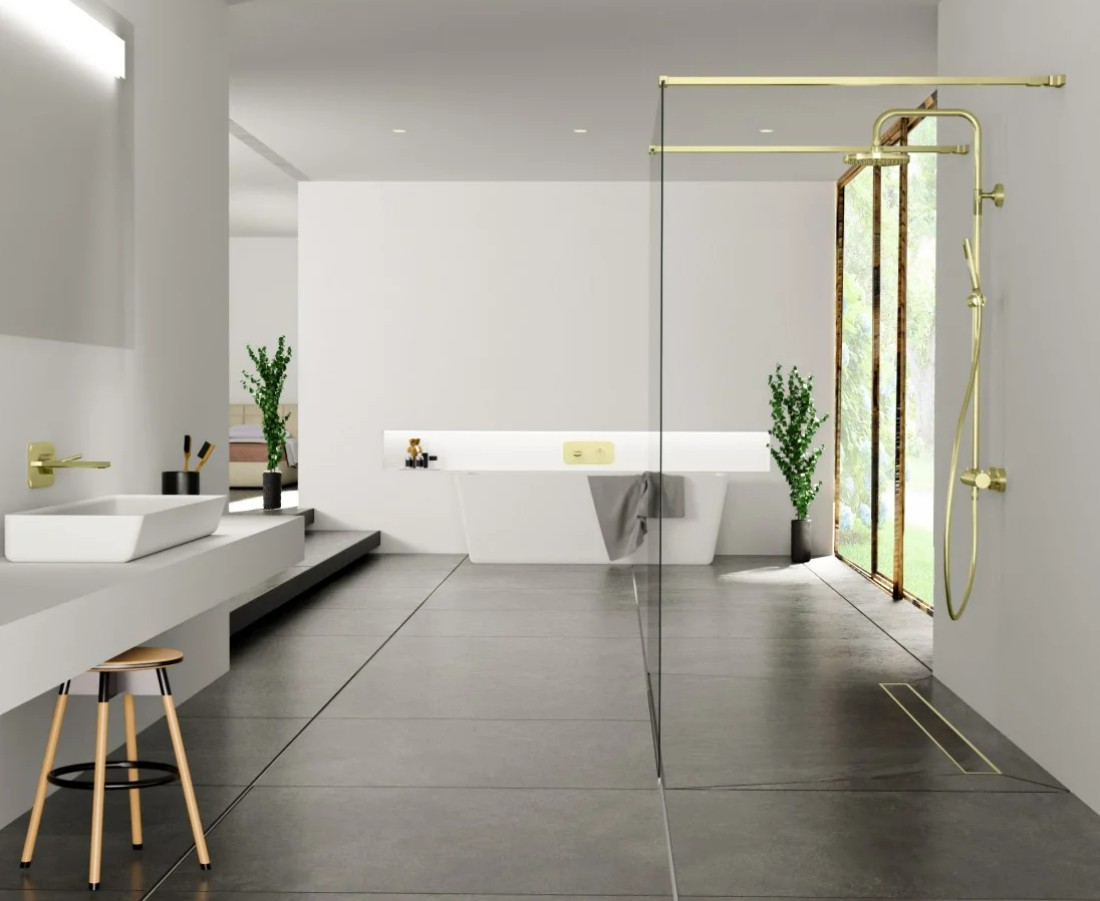
Quick overview of Shower Enclosures and Screens
Whether you opt for a raised tray, low-profile model, or wet room shower tray, choosing the right shower screen or enclosure is essential for both style and functionality. In some layouts, a single frameless screen can achieve a minimalist, open aesthetic. In others, a fully-enclosed door setup — with hinged, pivot, or sliding doors — offers better water containment. Framed and semi-framed enclosures provide a more traditional look, while frameless designs lend a sleek, modern vibe.
For added visual cohesion, consider matching hardware finishes — brackets, handles, and hinges — to your drain colour. As with any bathroom fixture, accurate measurements and high-quality materials help ensure a secure fit, easier cleaning, and a shower space that both performs well and looks great.
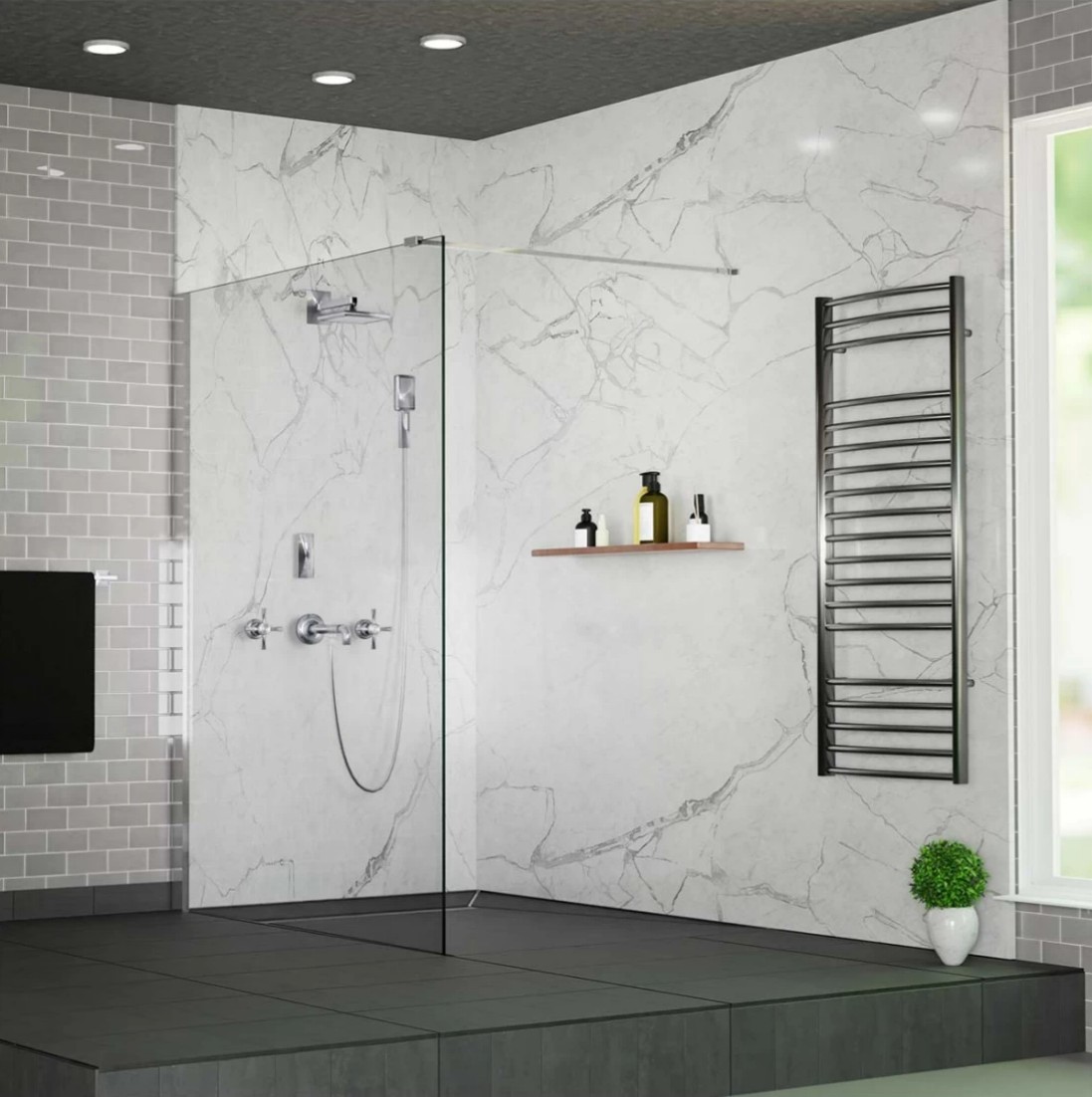
Choosing a Shower Tray – Important Installation Tips
Whether you’re installing a brand-new shower or replacing an old shower tray, it’s crucial to understand the basics of setup and waterproofing. Most shower trays come in various heights and materials, and some include adjustable legs to accommodate uneven floors. Also, remember that your shower enclosure must fit seamlessly with the tray for proper water containment.
Below is a broad overview of how the installation typically unfolds, broken down into three main phases:
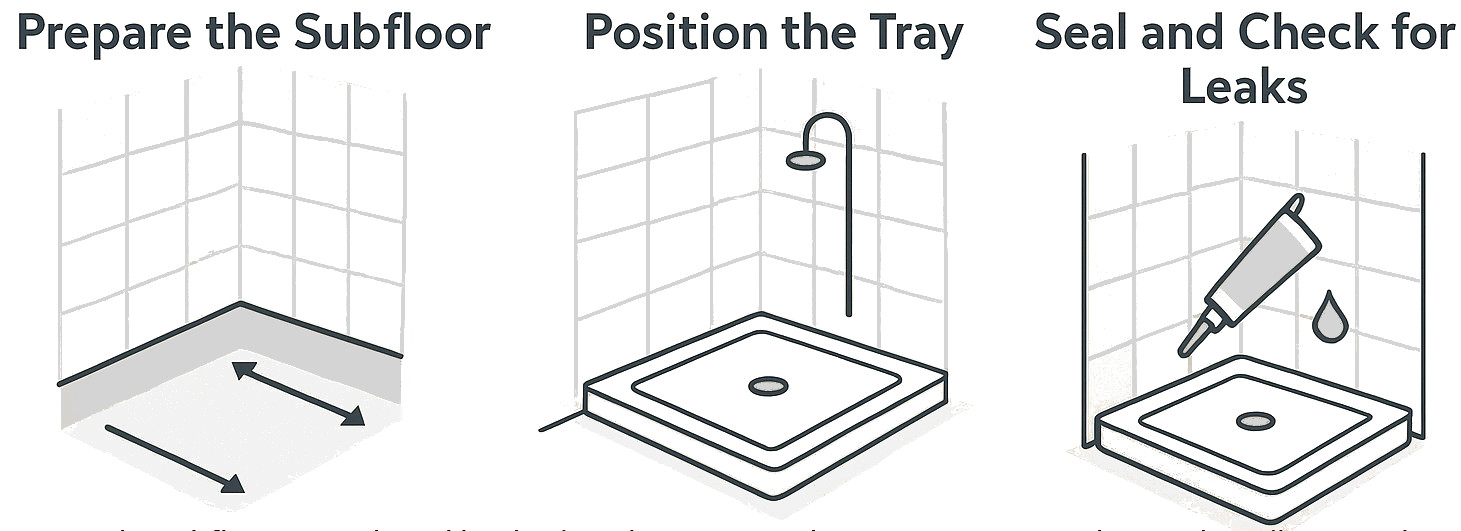
- Prepare the Subfloor
- Ensure the subfloor is sturdy and level.
- If you notice dips or raised sections, use a self-leveling compound or consider a tray with adjustable legs or a riser kit.
- Position the Tray
- Align the tray according to your measurements.
- Make sure the drain outlet lines up precisely with the waste pipe to prevent drainage issues.
- Seal and Check for Leaks
- Apply a quality silicone sealant around the tray edges.
- After connecting the plumbing, run water to confirm there are no leaks before installing wall tiles or enclosure fittings.
You can install a shower tray on your own if you have the right tools and a solid grasp of the process; just be sure to carefully follow the manufacturer’s instructions. If you’re not fully confident, hiring a qualified contractor ensures professional results and fewer surprises.
If you are into wet room shower trays solution, look at the detailed timber floor installation instructions or concrete floor instruction.
While installing your tray, remember that proper waterproofing is especially crucial around the drain area and any seams. Even a small leak can lead to significant damage over time—particularly if you’re working on upper floors. Whenever in doubt, consult a professional or refer back to the manufacturer’s installation guide for peace of mind.
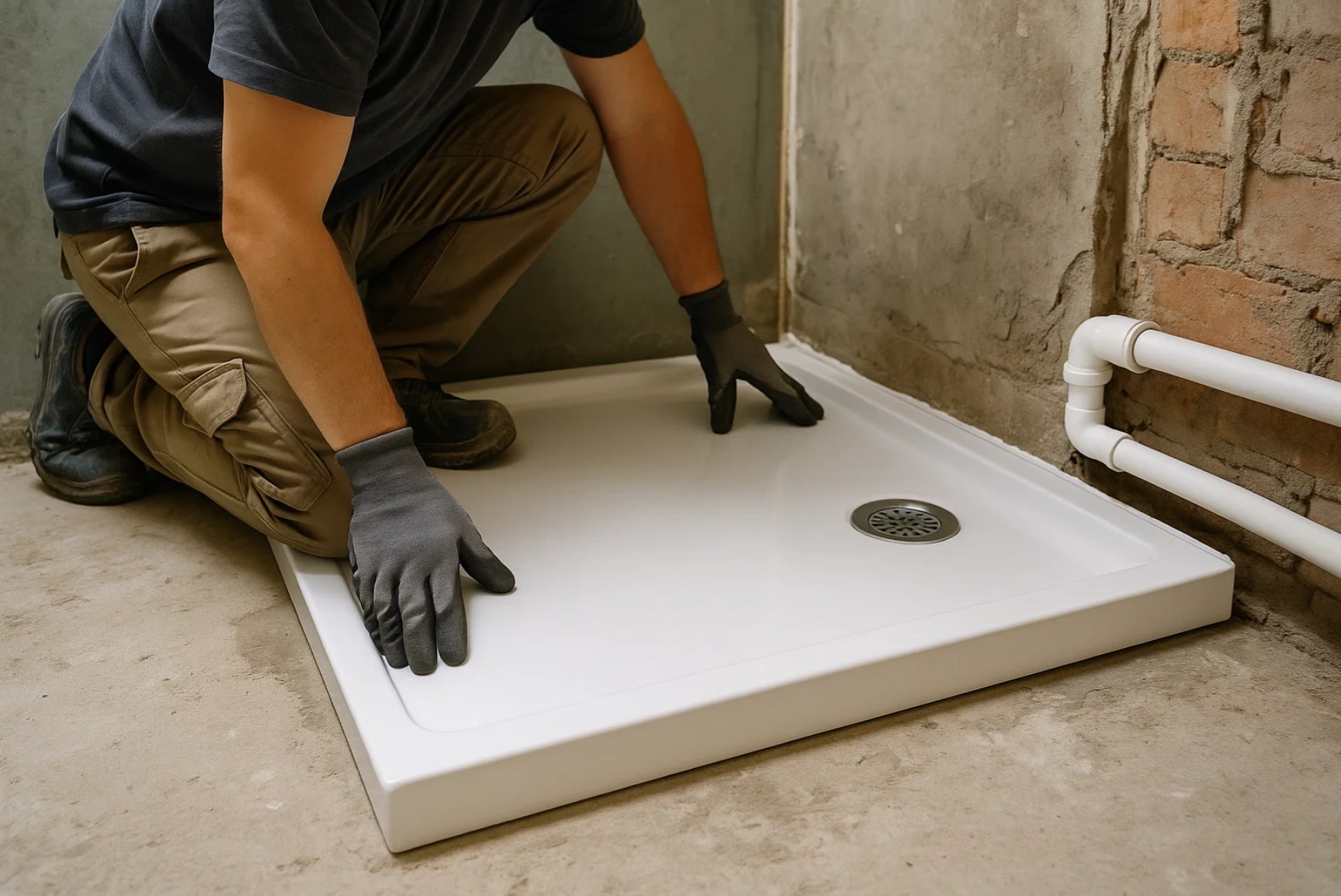
Before You Buy: How to Maintain Your Shower Tray and Enclosure
Regardless of whether you choose an acrylic tray, stone resin, or wet room solution, proper care will significantly extend the lifespan of both your shower enclosure and tray.
Regular Wiping
After each shower, give the surfaces a quick wipe-down to prevent water spots and soap scum buildup. This simple habit is particularly important if you have a wet room shower tray, as any pooled water can spread beyond the immediate shower area.
Gentle Cleansers
Opt for mild cleaning agents, such as diluted lemon juice or specialized non-abrasive products. These will help remove limescale and grime without damaging acrylic, stone resin, or the tile finish on a wet room tray.
Check Silicone Seals and Waterproofing
Periodically inspect the silicone around the tray edges, especially in wet room setups where waterproofing covers a larger surface. If you notice any peeling or gaps, reseal promptly to protect against leaks. While stone resin trays are particularly sturdy, maintaining seal integrity is essential for any shower installation.
How to Get Rid of Limescale and Soap Scum of Your Shower Screen
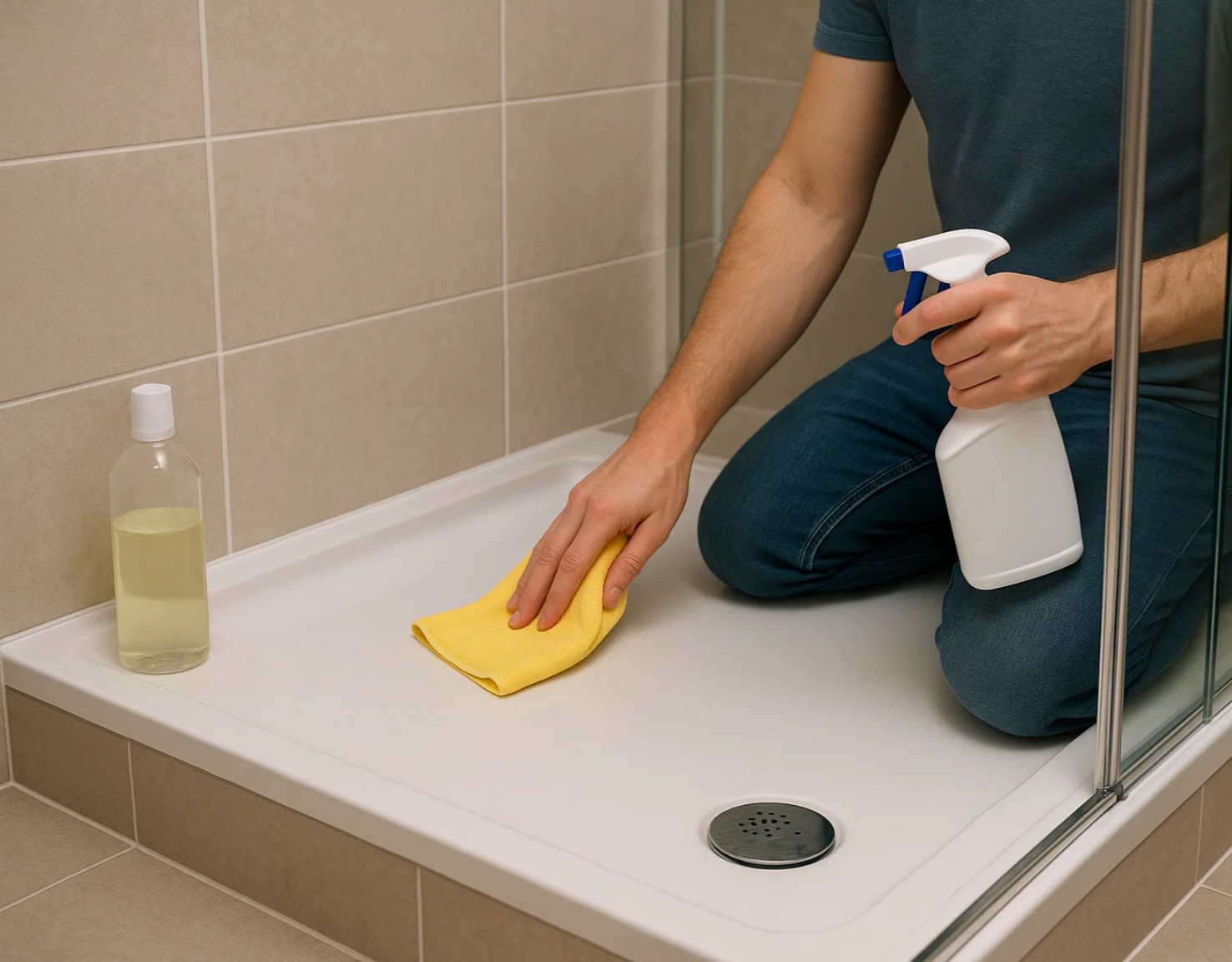
Key Shower Tray Buying Guide Takeaways
- Shower Tray Importance – A properly chosen tray offers comfort, durability, and efficient water drainage, whether you opt for a traditional shower space or a fully waterproofed wet room.
- Bathroom Layout & Tray Height – Consider the size and shape of your space, along with the plumbing setup, to decide whether you need a raised tray, a low-profile model, or a walk-in wet room design.
- Material Options – Acrylic is lightweight and budget-friendly; stone resin provides a luxurious feel; wet room trays blend seamlessly into the floor for a sleek, open look.
- Shapes & Sizes – From compact square trays in small bathrooms to elongated rectangular ones for larger spaces, the right shape and dimensions ensure both functionality and visual harmony.
- Measuring & Planning – Accurate measurements help avoid layout conflicts with doors and fixtures. Tools like a bathroom layout planner or detailed installation guides can clarify the process.
- Colour Choices – Traditional trays often come in neutral shades (white, off-white, black, or grey). Wet room trays can match your existing floor, with drain finishes available in silver, gold, brass, black, or even a fully tiled look.
- Installation Basics – Subfloor preparation, careful tray positioning, and thorough sealing are key steps. Proper waterproofing is especially critical around the drain and seams, particularly in upper-floor installations.
- Maintenance Tips – Regular wiping, gentle cleansers, and checking for silicone seal integrity prevent soap scum buildup, leaks, and other issues—ensuring a longer lifespan for any shower tray type.
By following this buying guide, you’re well on your way to picking the right tray — whether that means a minimal low-profile design or a practical raised tray solution. Enjoy creating a bathroom that suits both your functional needs and personal style!



